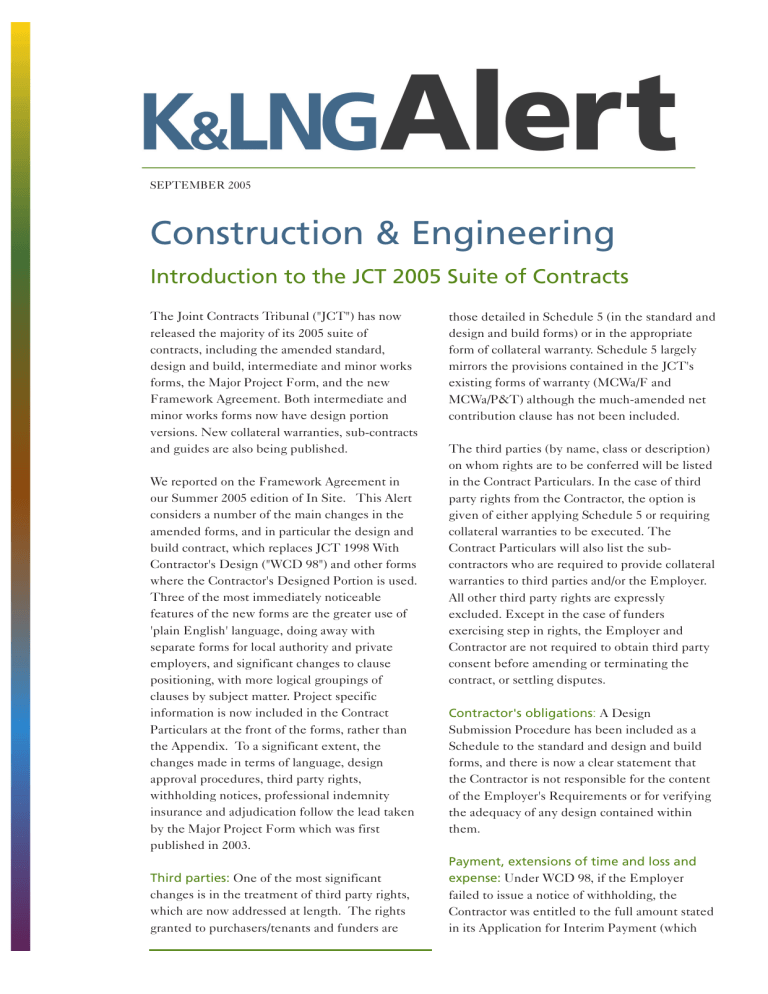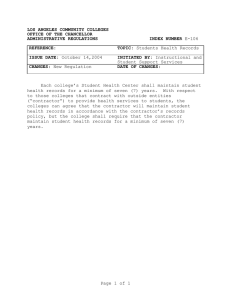Construction & Engineering Introduction to the JCT 2005 Suite of Contracts

SEPTEMBER 2005
Construction & Engineering
Introduction to the JCT 2005 Suite of Contracts
The Joint Contracts Tribunal ("JCT") has now released the majority of its 2005 suite of contracts, including the amended standard, design and build, intermediate and minor works forms, the Major Project Form, and the new
Framework Agreement. Both intermediate and minor works forms now have design portion versions. New collateral warranties, sub-contracts and guides are also being published.
We reported on the Framework Agreement in our Summer 2005 edition of In Site. This Alert considers a number of the main changes in the amended forms, and in particular the design and build contract, which replaces JCT 1998 With
Contractor's Design ("WCD 98") and other forms where the Contractor's Designed Portion is used.
Three of the most immediately noticeable features of the new forms are the greater use of
'plain English' language, doing away with separate forms for local authority and private employers, and significant changes to clause positioning, with more logical groupings of clauses by subject matter. Project specific information is now included in the Contract
Particulars at the front of the forms, rather than the Appendix. To a significant extent, the changes made in terms of language, design approval procedures, third party rights, withholding notices, professional indemnity insurance and adjudication follow the lead taken by the Major Project Form which was first published in 2003.
Third parties: One of the most significant changes is in the treatment of third party rights, which are now addressed at length. The rights granted to purchasers/tenants and funders are those detailed in Schedule 5 (in the standard and design and build forms) or in the appropriate form of collateral warranty. Schedule 5 largely mirrors the provisions contained in the JCT's existing forms of warranty (MCWa/F and
MCWa/P&T) although the much-amended net contribution clause has not been included.
The third parties (by name, class or description) on whom rights are to be conferred will be listed in the Contract Particulars. In the case of third party rights from the Contractor, the option is given of either applying Schedule 5 or requiring collateral warranties to be executed. The
Contract Particulars will also list the subcontractors who are required to provide collateral warranties to third parties and/or the Employer.
All other third party rights are expressly excluded. Except in the case of funders exercising step in rights, the Employer and
Contractor are not required to obtain third party consent before amending or terminating the contract, or settling disputes.
Contractor's obligations : A Design
Submission Procedure has been included as a
Schedule to the standard and design and build forms, and there is now a clear statement that the Contractor is not responsible for the content of the Employer's Requirements or for verifying the adequacy of any design contained within them.
Payment, extensions of time and loss and expense: Under WCD 98, if the Employer failed to issue a notice of withholding, the
Contractor was entitled to the full amount stated in its Application for Interim Payment (which
may well be greater than the amount 'due'). This has been addressed in the new form and, in the absence of a withholding notice, the Contractor is now only entitled to the amount 'due' to it in accordance with the interim payment assessment process.
The list of Relevant Events entitling the
Contractor to an extension of time has been shortened, although the allocation of risk has not changed. This is because the deleted events
(such as not having received necessary instructions in due time, the Employer's failure to supply goods and materials or to give ingress/egress in due time) are seen to be already covered by the general 'no impediment, prevention or default' provision added to the list of Relevant Events via Amendment 4 in 2002.
The list of matters (now defined as “Relevant
Matters”) entitling the Contractor to loss and expense has also been reduced.
Insurance : The insurance options of clauses
22A-C have been transferred out of the body of the contracts to Schedule 3, but clause 22D
(insurance for Employer's lost liquidated damages) has been removed.
The 1998 forms did not provide for professional indemnity insurance (this was hence a common feature of schedules of amendments). If (and only if) a level of cover has been specified in the
Contract Particulars, the new forms impose an obligation on the Contractor to take out and, subject to commercially reasonable rates being available, maintain such cover. Unless other details are included in the Contract Particulars, cover will be on an annual aggregate basis and required to be maintained for a 6 year period.
Copyright: The 1998 forms did not deal with copyright, and hence this was another common feature of schedules of amendments. The new forms grant the Employer an irrevocable royaltyfree copyright licence in respect of the
Contractor's Design Documents. This licence is however stated as being granted 'subject to' the
Contractor having been paid all monies due under the contract. This provision is likely to be amended.
Disputes: Provision has been included for mediation, and adjudications are now governed by the Scheme for Construction Contracts rather than the detailed provisions included in each of the 1998 forms. The default position for the final determination of disputes has been altered from arbitration to litigation.
The way forward: The 1998 forms are likely to remain the preferred choice in the short term for three main reasons: custom and familiarity; the currently incomplete roll out means there would be a risk of inconsistencies and the incomplete/improper passing of risks if the new head contract forms were used without the new sub-contracts and collateral warranties; and there will currently be numerous projects on the books that have already been through an initial bid process based on the 1998 forms.
Having said this, however, both employers and contractors should begin to familiarise themselves with the new forms.
If you would like further information about the new JCT suite, or have specific issues which you would like to discuss further, please contact
Kevin Greene email: kgreene@klng.com
tel: +44 (0)20 7360 8188
Inga Hall email: ihall@klng.com
tel: +44 (0)20 7360 8137 www.klng.com
BOSTON • DALLAS • HARRISBURG • LONDON • LOS ANGELES • MIAMI • NEWARK • NEW YORK • PALO ALTO • PITTSBURGH • SAN FRANCISCO • WASHINGTON
Kirkpatrick & Lockhart Nicholson Graham (K&LNG) has approximately 1,000 lawyers and represents entrepreneurs, growth and middle market companies, capital markets participants, and leading FORTUNE 100 and FTSE 100 global corporations nationally and internationally.
K&LNG is a combination of two limited liability partnerships, each named Kirkpatrick & Lockhart Nicholson Graham LLP, one qualified in Delaware, U.S.A. and practicing from offices in Boston, Dallas, Harrisburg, Los Angeles, Miami, Newark, New York, Palo Alto, Pittsburgh, San Francisco and Washington and one incorporated in England practicing from the London office.
This publication/newsletter is for informational purposes and does not contain or convey legal advice. The information herein should not be used or relied upon in regard to any particular facts or circumstances without first consulting a lawyer.
Data Protection Act 1998 - We may contact you from time to time with information on Kirkpatrick & Lockhart Nicholson Graham LLP seminars and with our regular newsletters, which may be of interest to you. We will not provide your details to any third parties. Please e-mail cgregory@klng.com if you would prefer not to receive this information.
© 2005 KIRKPATRICK & LOCKHART NICHOLSON GRAHAM LLP. ALL RIGHTS RESERVED.


